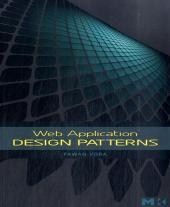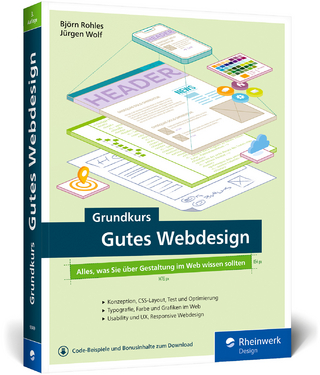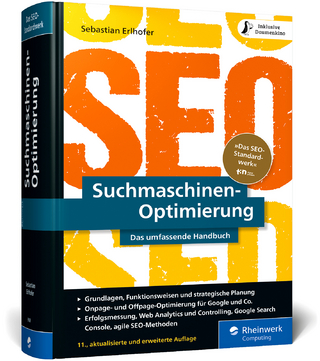
Web Application Design Patterns
Morgan Kaufmann Publishers In (Verlag)
978-0-12-374265-0 (ISBN)
Ever notice that—in spite of their pervasiveness—designing web applications is still challenging? While their benefits motivate their creation, there are no well-established guidelines for design. This often results in inconsistent behaviors and appearances, even among web applications created by the same company.
Design patterns for web applications, similar in concept to those for web sites and software design, offer an effective solution. In Web Application Design Patterns, Pawan Vora documents design patterns for web applications by not only identifying design solutions for user interaction problems, but also by examining the rationale for their effectiveness, and by presenting how they should be applied.
Pawan Vora is the founder and president of Alpha Cube, Inc., a user experience design consultancy focused on designing, reviewing, and evaluating user interfaces for software and web-based applications. He has been a user experience professional for more than 14 years and has designed user interfaces for a range of applications for business-to-consumer, business-to-business, consumer-to-consumer, and business-to-employee environments. He has published and conducted a number of tutorials and in-house training workshops on web site design, web application design, and design patterns in the United States and internationally.Pawan has a Ph.D. and M.S. in industrial engineering from the State University of New York at Buffalo in addition to his bachelor’s degrees in production engineering and mechanical engineering from Victoria Jubilee Technical Institute in Mumbai, India.
Ch 1. Introduction: 1.1 WEB APPLICATIONS; 1.2 DESIGN PATTERNS; 1.3 ORGANIZATION OF PATTERNS; 1.4 USING PATTERNS IN THIS BOOK Ch 2. Forms: 2.1 CLEAR BENEFITS; 2.2 SHORT FORMS; 2.3 LOGICAL GROUPING; 2.4 LABEL POSITION; 2.5 REQUIRED FIELD INDICATORS; 2.6 SMART DEFAULTS; 2.7 FORGIVING FORMAT; 2.8 KEYBOARD NAVIGATION; 2.9 INPUT HINTS/PROMPTS; 2.10 ACTION BUTTONS; 2.11 INFORMATIVE ERROR MESSAGES Ch 3. Accessing and Exiting Web Applications: 3.1 REGISTER; 3.2 LOG IN; 3.3 LOG OUT; 3.4 AUTOMATIC TIMEOUT; 3.5 FORGOT LOGIN; 3.6 CAPTCHA Ch 4. Application Main page: 4.1 HOME; 4.2 PORTAL; 4.3 DASHBOARD; 4.4 CUSTOMIZATION; 4.5 PERSONALIZATION; 4.6 SKINS Ch 5. Navigating Applications: 5.1 GLOBAL NAVIGATION; 5.2 LOCAL NAVIGATION; 5.3 UTILITY NAVIGATION; 5.4 FACETED NAVIGATION 5.5 WIZARDS; 5.6 TAG CLOUDS; 5.7 BREADCRUMBS Ch 6. Search and Filtering: 6.1 SIMPLE SEARCH; 6.2 PARAMETRIC SEARCH; 6.3 SEARCH RESULTS; 6.4 ADVANCED SEARCH; 6.5 SEARCH TIPS; 6.6 SEARCH PAGINATION; 6.7 CONTINUOUS SCROLLING; 6.8 SAVED SEARCHES; 6.9 SORTING; 6.10 COLUMN FILTERING; 6.11 FILTERING Ch 7. Displaying and Manipulating Data: 7.1 GRIDS; 7.2 THREADED LISTS; 7.3 PAGINATION 7.4 CUSTOM VIEWS; 7.5 REPORTS; 7.6 PRINTER-FRIENDLY; 7.7 DETAILS; 7.8 EDITOR; 7.9 CONFIGURATOR; 7.10 COMPARISONS; 7.11 PROGRESSIVE DISCLOSURE; 7.12 UPLOAD/DOWNLOAD; 7.13 FEEDBACK/RATING; 7.14 CONTROL PANEL; 7.15 CHARTS; 7.16 ALBUM/GALLERY Ch 8. Rich Internet Applications: 8.1 RICH-TEXT EDITOR; 8.2 RICH FORM; 8.3 AUTO-SUGGEST/AUTO-COMPLETION; 8.4 EDIT-IN-PLACE; 8.5 OVERVIEW-PLUS-DETAIL; 8.6 DYNAMIC QUERYING; 8.7 LIVE PREVIEW; 8.8 DRAG-AND-DROP; 8.9 SLIDER; 8.10 ANIMATIONS/TRANSITIONS; 8.11 DELAY/PROGRESS INDICATORS; 8.12 SPOTLIGHT/YELLOW-FADE; 8.13 CAROUSEL Ch 9. Community and Collaboration: 9.1 USER PROFILE/AVATAR; 9.2 SPECIAL INTEREST COMMUNITY; 9.3 MY FRIENDS; 9.4 SHARED NETWORK 9.5 FEEDBACK/RATING; 9.6 RECOMMENDATION; 9.7 DISCOVER NETWORK MEMBERS; 9.8 SOCIAL RESPONSIBILITY; 9.9 SHARING; 9.10 SYNCHRONOUS/ASYNCHRONOUS MESSAGING; 9.11 SHARED SCHEDULE/CALENDAR; 9.12 HISTORY; 9.13 FORUMS; 9.14 BLOGS Ch 10. Internationalization and Localization: 10.1 COUNTRY IDENTIFICATION; 10.2 FORMS; 10.3 LANGUAGE; 10.4 CURRENCY; 10.5 DATE Ch 11. Help: 11.1 INLINE HELP; 11.2 CONTEXTUAL HELP; 11.3 FREQUENTLY ASKED QUESTIONS; 11.4 APPLICATION HELP; 11.5 HOW TO GUIDES/GUIDED TOURS; 11.6 HELP WIZARDS; 11.7 COMMUNITY HELP Ch 12. Accessibility: 12.1 PROGRESSIVE ENHANCEMENT; 12.2 SEMANTIC STRUCTURE; 12.3 UNOBTRUSIVE STYLE SHEETS; 12.4 UNOBTRUSIVE JAVASCRIPT; 12.5 ACCESSIBLE FORMS; 12.6 ACCESSIBLE IMAGES; 12.7 ACCESSIBLE TABLES; 12.8 ACCESSIBLE NAVIGATION; 12.9 ACCESSIBLE ALTERNATIVE Ch 13. Visual Design: 13.1 LIQUID-WIDTH LAYOUT; 13.2 FIXED-WIDTH LAYOUT; 13.3 PROGRESSIVE LAYOUT; 13.4 GRID STRUCTURE; 13.5 VISUAL HIERARCHY; 13.6 HIGHLIGHT; 13.7 ICONS; 13.8 VISUAL EFFECTS Ch 14. Using Patterns and Pattern Libraries; 14.1 INTERACTION LEVEL AND PAGE LEVEL PATTERNS; 14.2 PATTERN LIBRARIES
| Reihe/Serie | Interactive Technologies |
|---|---|
| Verlagsort | San Francisco |
| Sprache | englisch |
| Maße | 191 x 235 mm |
| Gewicht | 920 g |
| Themenwelt | Mathematik / Informatik ► Informatik ► Netzwerke |
| Informatik ► Web / Internet ► Web Design / Usability | |
| ISBN-10 | 0-12-374265-X / 012374265X |
| ISBN-13 | 978-0-12-374265-0 / 9780123742650 |
| Zustand | Neuware |
| Haben Sie eine Frage zum Produkt? |
aus dem Bereich


